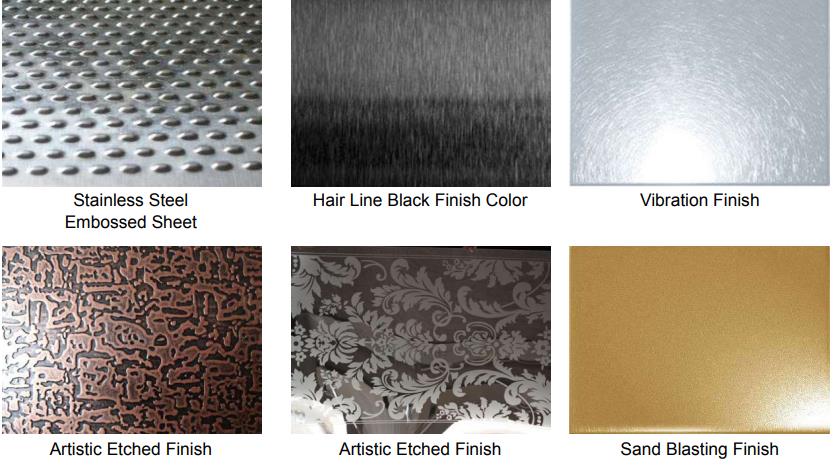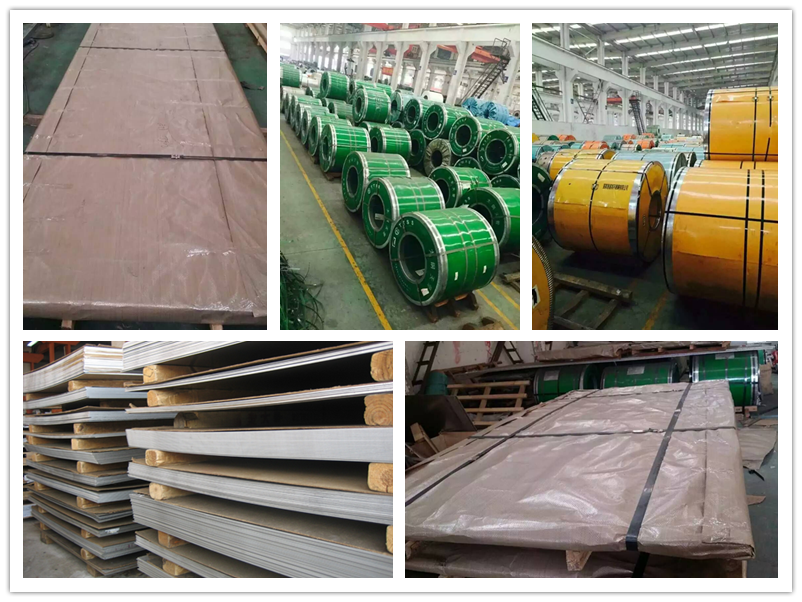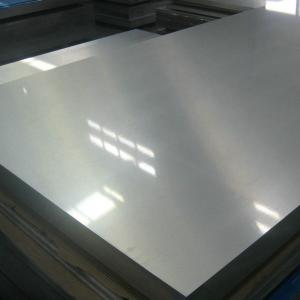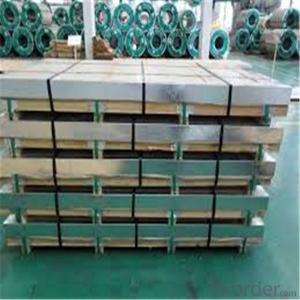Wholesale 201 Stainless Steel Sheet Embossed Sheets Plates
- Loading Port:
- Shanghai
- Payment Terms:
- TT or LC
- Min Order Qty:
- 25 m.t.
- Supply Capability:
- 2000 m.t./month
OKorder Service Pledge
OKorder Financial Service
You Might Also Like
Item specifice
Stainless steel which can be produced in different chemical, physical and mechanical properties, have high corrosion and heat resistance, mechanical strength, manufacturing ease, aesthetic appearance hygienic and long lasting properties.
STANDARDS
ASTM A240/A240M,ASME A240/A240,EN 10088-2, EN10028-7,JIS G 4305
| Decoration Stainless Steel Sheet / Plate | |
| Size | Thickness 0.02mm-3mm, Width and Length can be customized |
| Grade | SUS 201, 202, 304L/H, 316L/H, 321/H, 317/H, 347/H, 310S, 430, 409/L, 31803, 32750, 32760, etc |
| Standard | JIS,EN,ASTM,AISI |
| Finish | 2B, HL, NO.4, BA, Mirror, Embossed, Colored, Vibration, Sand blasting, Artistic etched etc. |
| Application | Elevator, Carbin Decoration, Building Decoration, Architectural Decoration, Kitchen Decoration |
Stainless Steel Sheet Series
Stainless Steel Polished Sheet (8K Mirror, Hairline, Grit 240,320)
Embossed Stainless Steel Sheet
Etched Stainless Steel Sheet,
PVD Colored Stainless Steel Sheet,
Perforated Stainless Steel Plate
Chequered Stainless Steel Sheet

Packaging & Shipping

Application
Kitchen, Subway, Hospital, Door, Frame of Door, Structure, Machine, Pipe, Utensil, Internal Decoration of Elevator.

- Q:What is the composition of stainless steel sheets?
- Stainless steel sheets are primarily composed of iron, chromium, and varying amounts of other elements such as nickel, manganese, and carbon. The main component, iron, provides the strength and durability of the sheets, while chromium is added to enhance corrosion resistance. The addition of nickel increases the sheets' resistance to high temperatures and improves their overall mechanical properties. Manganese is added to enhance the sheets' formability, and carbon is added to improve their hardness. These elements work together to create a versatile and highly reliable material that is commonly used in various industries, including construction, automotive, and manufacturing.
- Q:How do stainless steel sheets differ from other types of sheets?
- Stainless steel sheets differ from other types of sheets in terms of their composition and properties. Unlike regular sheets, stainless steel sheets are made primarily of an alloy that contains a high percentage of chromium, which provides excellent corrosion resistance. This makes stainless steel sheets highly durable and suitable for various applications, including in industries like construction, automotive, and food processing. Additionally, stainless steel sheets are known for their aesthetic appeal, as they have a shiny and polished surface that adds a modern and sleek look to any project.
- Q:Can stainless steel sheets be used for elevator mirrors?
- Yes, stainless steel sheets can be used for elevator mirrors. Stainless steel is a durable and versatile material that offers a sleek and polished appearance, making it a popular choice for elevator interiors. Stainless steel sheets can be polished to a high mirror-like finish, allowing them to serve as reflective surfaces for mirrors in elevators. Additionally, stainless steel is resistant to corrosion, making it suitable for the humid and often harsh environments found in elevators.
- Q:Seeking stainless steel plate 304 material and 304j material what is the difference?
- 304 applications: petroleum, chemical, pharmaceutical, food, machinery, aerospace, construction, military, hardware, boilers, gas, plumbing and heating equipment, ships, power plants and other industries.
- Q:What is the maximum operating temperature for stainless steel sheets?
- The maximum operating temperature for stainless steel sheets can vary depending on the grade of stainless steel, but it typically ranges between 1500-1650°F (816-899°C).
- Q:How do you install stainless steel sheets?
- In order to install stainless steel sheets, there are a few basic tools you will need and some steps that should be followed: 1. Begin by measuring and preparing the area where you intend to install the stainless steel sheets. Ensure that the surface is clean, dry, and free from any dust or debris. If necessary, smooth out any rough spots or imperfections on the surface by sanding them down. 2. Cut the sheets to the desired size and shape using a metal cutting tool such as a circular saw or a jigsaw with a metal cutting blade. For your safety, remember to wear protective goggles and gloves while cutting. 3. Apply a high-strength construction adhesive to the backside of the stainless steel sheet. Ensure that the adhesive is applied evenly, without leaving any gaps or air pockets. To achieve better coverage, you may use a notched trowel to spread the adhesive. 4. Carefully position the stainless steel sheet onto the prepared surface, making sure it is properly aligned. Apply gentle and consistent pressure to ensure that the sheet adheres to the surface. A roller or clean cloth can be used to firmly press the sheet onto the surface. 5. If necessary, use stainless steel screws to further secure the sheet. Place the screws evenly along the edges and corners, ensuring proper spacing. Be cautious not to overtighten the screws in order to avoid damaging the sheet. 6. Trim any excess stainless steel sheet that hangs over the edges to achieve the desired size. Use a metal cutting tool for this task. Once trimmed, smooth out any rough edges with a file or sandpaper. To give the sheet a polished finish and remove any smudges or fingerprints, a stainless steel cleaner can be used. Always make sure to follow the manufacturer's instructions for the specific stainless steel sheets you are using, as installation methods may slightly vary. If you are unsure or uncomfortable with the installation process, it is recommended to seek professional assistance.
- Q:Can stainless steel sheets be used for roofing applications?
- Yes, stainless steel sheets can be used for roofing applications. Stainless steel is a durable and corrosion-resistant material, making it suitable for use in outdoor environments. It is commonly used in architectural applications, including roofing, due to its strength, longevity, and aesthetic appeal. Stainless steel roofing sheets are available in different thicknesses and profiles, allowing for versatility in design. Additionally, stainless steel is fire-resistant and can withstand extreme weather conditions, making it a reliable choice for roofs.
- Q:How do you determine the thickness of stainless steel sheets required for a specific application?
- To ascertain the necessary thickness of stainless steel sheets for a particular application, one must take into account various factors. 1. Load-bearing capacity: The initial step involves determining the maximum load that the stainless steel sheets will need to bear. This can be calculated by considering the weight of the objects or materials that will be placed on the sheets. It is essential to factor in any potential dynamic loads or impact forces that may be exerted. 2. Deflection limits: Deflection pertains to the degree of bending or sagging that occurs when a load is applied to the stainless steel sheets. The limits of deflection will depend on the specific application and the desired performance of the sheets. In general, minimizing deflection is vital for structural integrity and ensuring that the stainless steel sheets can withstand the intended load without excessive bending. 3. Material properties: Stainless steel sheets come in different grades, each possessing its own mechanical properties. The tensile strength, yield strength, and hardness of the stainless steel should be taken into consideration to ensure it can withstand the required load and any potential environmental conditions, such as corrosion or extreme temperatures. 4. Safety factors: It is crucial to incorporate appropriate safety factors to provide a margin of safety for the stainless steel sheets. Safety factors account for uncertainties in load calculations, material properties, and other variables. The safety factor may vary depending on the desired level of confidence, but it is typically recommended to apply a safety factor of at least 1.5 to 2. 5. Industry standards and regulations: Depending on the specific application, there may be industry standards or regulations that specify the minimum thickness requirements for stainless steel sheets. It is important to consult these standards and ensure compliance to guarantee that the sheets meet all safety and performance requirements. By considering these factors and conducting engineering calculations, one can determine the appropriate thickness of stainless steel sheets needed for a specific application. It is always advisable to consult with an experienced engineer or a reputable stainless steel supplier to ensure accurate calculations and to address any specific requirements or unique considerations pertaining to the application.
- Q:Are stainless steel sheets available in different colors?
- Typically, stainless steel sheets are solely offered in their natural silver color, not in other hues. Stainless steel is a steel alloy with chromium, which imparts its distinctive silver look. Although it is feasible to apply different coatings or finishes to stainless steel sheets for alternative colors like black or gold, these choices are not commonly provided. Nevertheless, alternatives such as powder coating or painting can be explored to achieve different colors on stainless steel sheets, but these methods might impact the material's ability to resist corrosion and endure over time.
- Q:Are stainless steel sheets resistant to acetic acid?
- Yes, stainless steel sheets are generally resistant to acetic acid.
1. Manufacturer Overview |
|
|---|---|
| Location | |
| Year Established | |
| Annual Output Value | |
| Main Markets | |
| Company Certifications | |
2. Manufacturer Certificates |
|
|---|---|
| a) Certification Name | |
| Range | |
| Reference | |
| Validity Period | |
3. Manufacturer Capability |
|
|---|---|
| a)Trade Capacity | |
| Nearest Port | |
| Export Percentage | |
| No.of Employees in Trade Department | |
| Language Spoken: | |
| b)Factory Information | |
| Factory Size: | |
| No. of Production Lines | |
| Contract Manufacturing | |
| Product Price Range | |
Send your message to us
Wholesale 201 Stainless Steel Sheet Embossed Sheets Plates
- Loading Port:
- Shanghai
- Payment Terms:
- TT or LC
- Min Order Qty:
- 25 m.t.
- Supply Capability:
- 2000 m.t./month
OKorder Service Pledge
OKorder Financial Service
Similar products
New products
Hot products
Hot Searches
Related keywords































